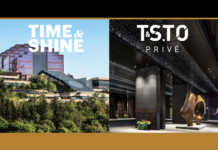
The patriotic purchase, Canadian diamonds are quality, conscience and completely dazzling
by Liza Marley
Buying local is one of the biggest trends to hit retail in the past decade, and that includes buying local diamonds. Canadian diamonds are a vital part of the international diamond trade and are significantly embraced in the Canadian jewellery market. With several mines in the northernmost reaches of the country, Canada is one of the major players in terms of production, along with Russia, Australia, and of course, several African countries. In 2009, Natural Resources Canada placed our country second in the world for being the largest producer of diamonds – behind Russia – based on value as opposed to production volume1. In 2013, The Mining Association of Canada (MAC) ranked Canada fourth in the world in global production. In fact, MAC reports that in 2012, Canada produced 10.4 million carats, with a value of $2,005,000,0002.
Sassan Parfour, vice president and one of the principals of the west coast jewellery chain Lugaro, says the market really embraces Canadian diamonds for several reasons. “They’re conflict free, they support our country, they support the industry, and they’re comparable in price,” he says. “They used to be a bit more expensive in the beginning, but now they’re comparable to the industry.”
While buying local and supporting Canadian industry has always been considered a patriotic practice, being “conflict free” is a very big deal. Canadian diamonds carry a microscopic etching along with a certificate of authenticity, guaranteeing each diamond’s origins. While the conflict diamond trade may comprise an increasingly smaller and smaller part of the market, “and reputable jewellers buy from conflict-free sources,” says Parfour, it’s still an important factor. It’s the conscionable choice.
You can never underestimate the effects of Hollywood on the consumer. Conflict – or ‘blood’ diamonds – were placed front and centre in the minds of the consumer with the 2006 blockbuster Blood Diamond starring Leonardo DiCaprio. Detailing the human rights abuses and the heinous militant regimes using the illegal diamond market to further their deadly and destructive causes, consumers see and understand a Canadian diamond as free from conflict.
“The movie was quite beneficial for our business,” says Parfour, “because people thought twice.” In addition to armed conflict, the damage done through the process of mining conflict diamonds is destructive to the environment. Buyers of Canadian diamonds are guaranteed that all handling of their diamond is done within the sphere of best practices: workers are safe, paid fair wages and that the process is environmentally sound – and the proceeds support Canadian industry, not armed conflict.
The certificate, Parfour explains, is just as important as the etching. “It’s the birth of the stone; how it was born, and where; how it arrived in your hands.” Including information about chronology, raw weight, cutting process, etc., the consumer is provided with an extensive overview of the diamond’s history and process. It becomes more than just a stone.
“Even in the U.S., Canadian diamonds are becoming in demand,” he says, including prestige companies like, “Ben Bridge – a national U.S. chain carries them.”
Many Canadian jewellery stores don’t just carry a selection of Canadian diamonds – both set and loose – but jewellers like Lugaro, Birks, Peoples Jewellers, and Ben Moss among many others, have complete collections devoted to Canadian diamonds, giving them iconic status, as they’re quite sought after by an increasingly educated and well-informed consumer.
While most of the focus with diamond purchases is on the finished product, the other side of the business is enormous. And impressive. Canada has numerous mines owned by various partnerships and companies. Each produces huge quantities of diamonds for the market. The most prominent are Ekati – Canada’s first producing mine, Diavik Mine, Snap Lake Project and Victor Project, with ongoing exploration adding to the annual production.
Canadian diamond mining is great for the economy, both in production and in employment. While Rio Tinto Diamonds mines all over the world, it is the majority stakeholder in Canada’s Diavik Diamond Mine, which is located just south of the Arctic Circle in the remote Northwest Territories.
This past November, Rio Tinto Diamonds approved the development of an additional pipeline. This will add to the country’s total production. It will also bring more work to the residents in surrounding communities. Diavik Diamond Mines President Marc Cameron said, “This is great news for Diavik, but also for the local communities in which we operate where we are committed to delivering economic and social benefits that will endure beyond the life of the Diavik mine.” He explains, “The mine produces predominantly gem-quality diamonds destined for high-end jewellery in all major consumer markets around the world.”
“Canadian diamonds from Rio Tinto’s Diavik Diamond mine are in strong demand in all established and emerging consumer markets. Recognized as especially white, lustrous and filled with a brilliant fire, our Diavik diamonds are mined using innovative engineering practices, environmentally sustainable mining practices and collaborative work with indigenous communities,” says Brandee Dallow, head of Rio Tinto Diamonds North America Representative Office.
With such tremendous value and rich experience, the diamond deserves the spotlight it receives, though the end consumer doesn’t likely give much thought to the long journey, the exploration, discovery, extraction, refinement and the millions of years it’s taken to become a beautiful piece of jewellery. A central product to two distinct industries – mining and jewellery retail – it’s amazing how a diamond transforms from traded commodity into opulent luxury, all the while maintaining its quality and character. In so many ways, a Canadian diamond truly is an intricate thing with many facets. CJ
1 http://www.nrcan.gc.ca/mining-materials/markets/canadian-minerals-yearbook/2009/8464
2 http://mining.ca/sites/default/files/documents/FactsandFigures2013.pdf


















